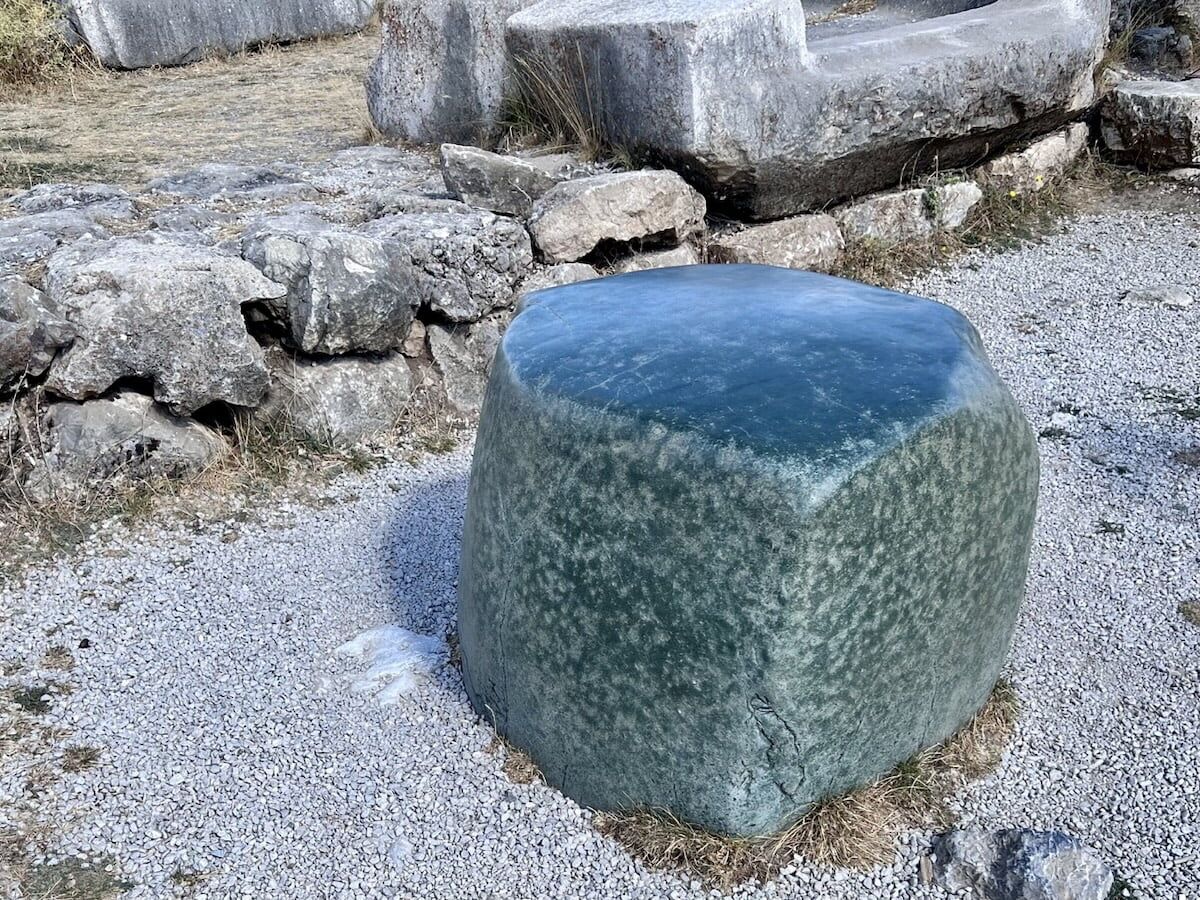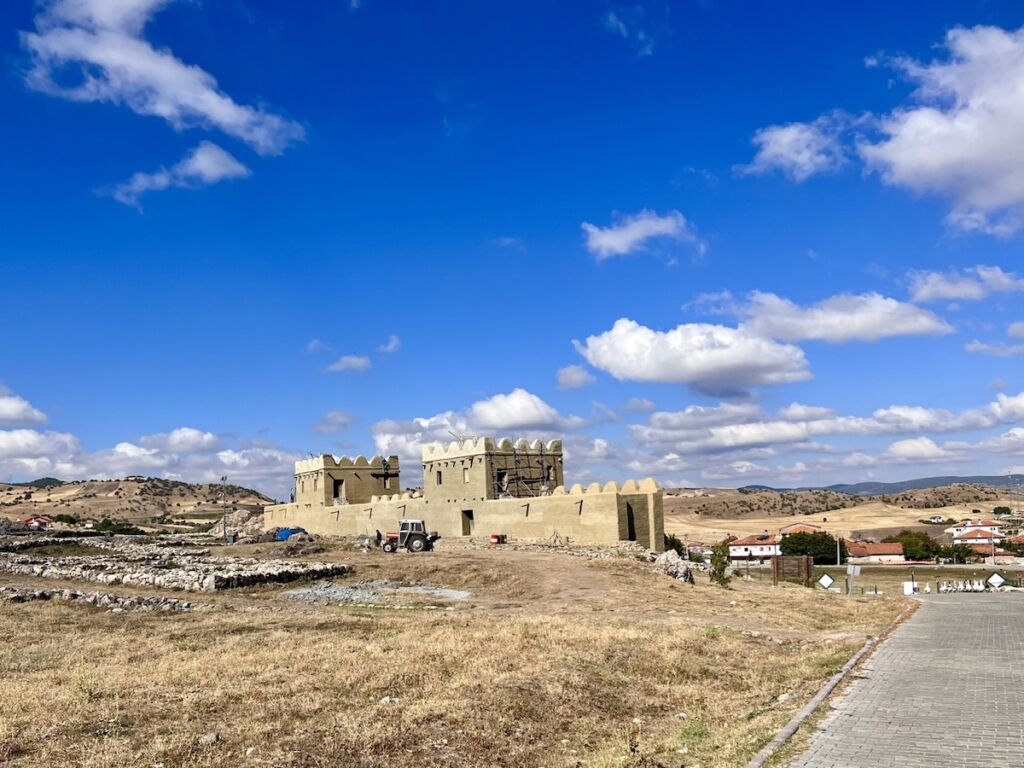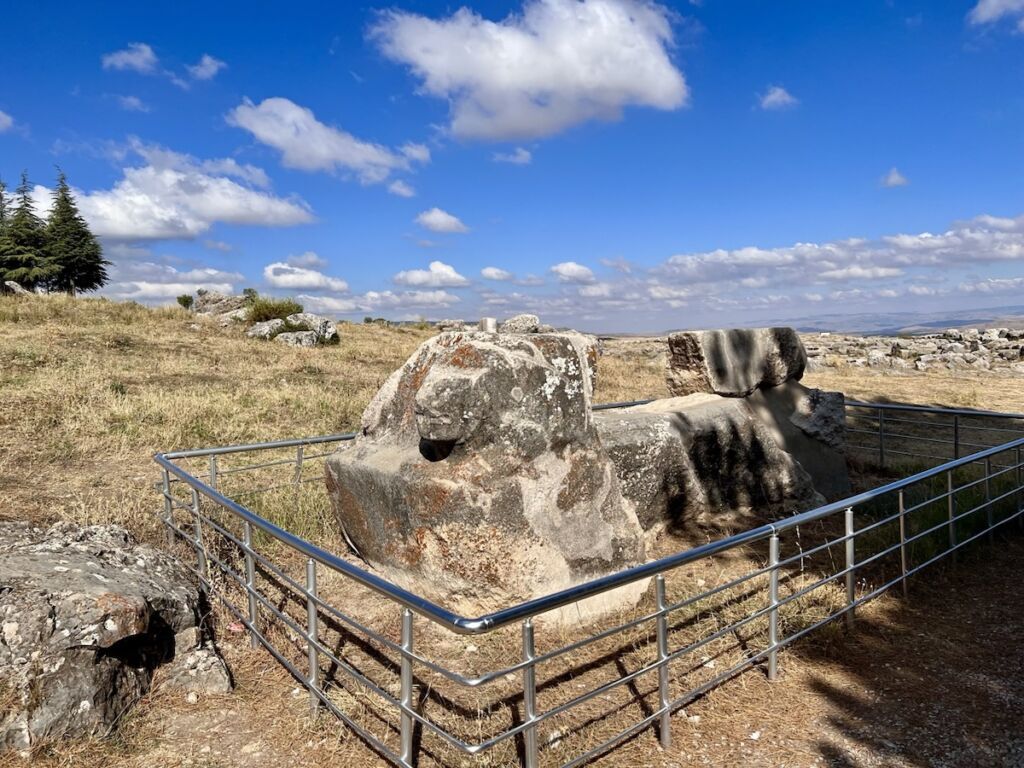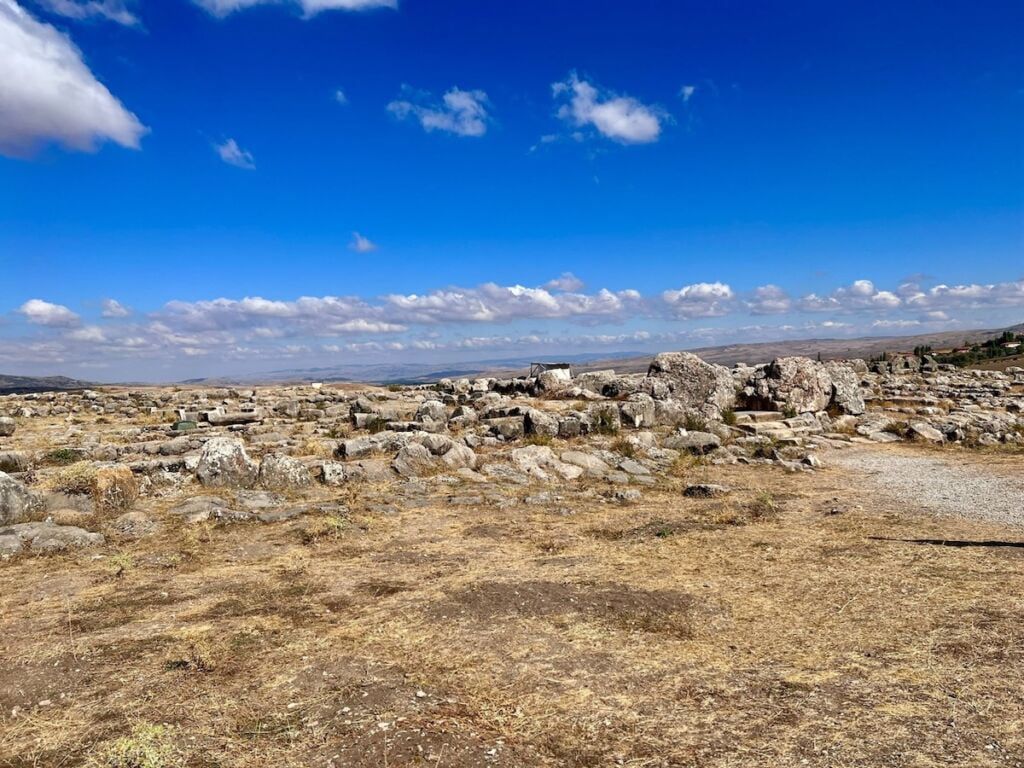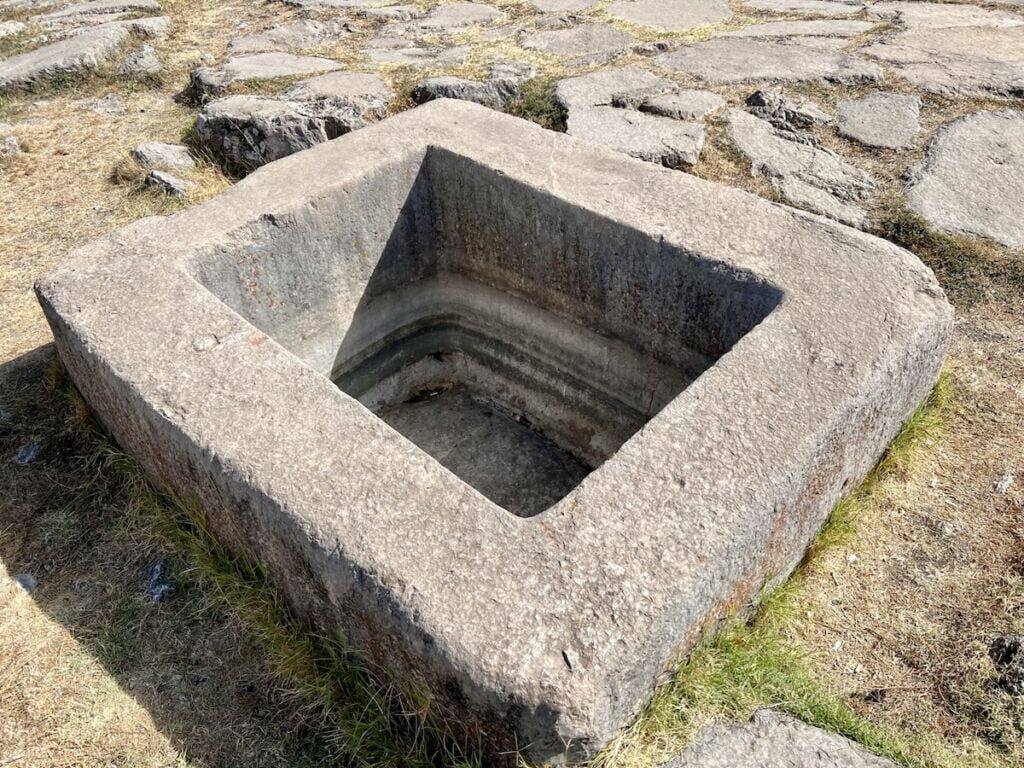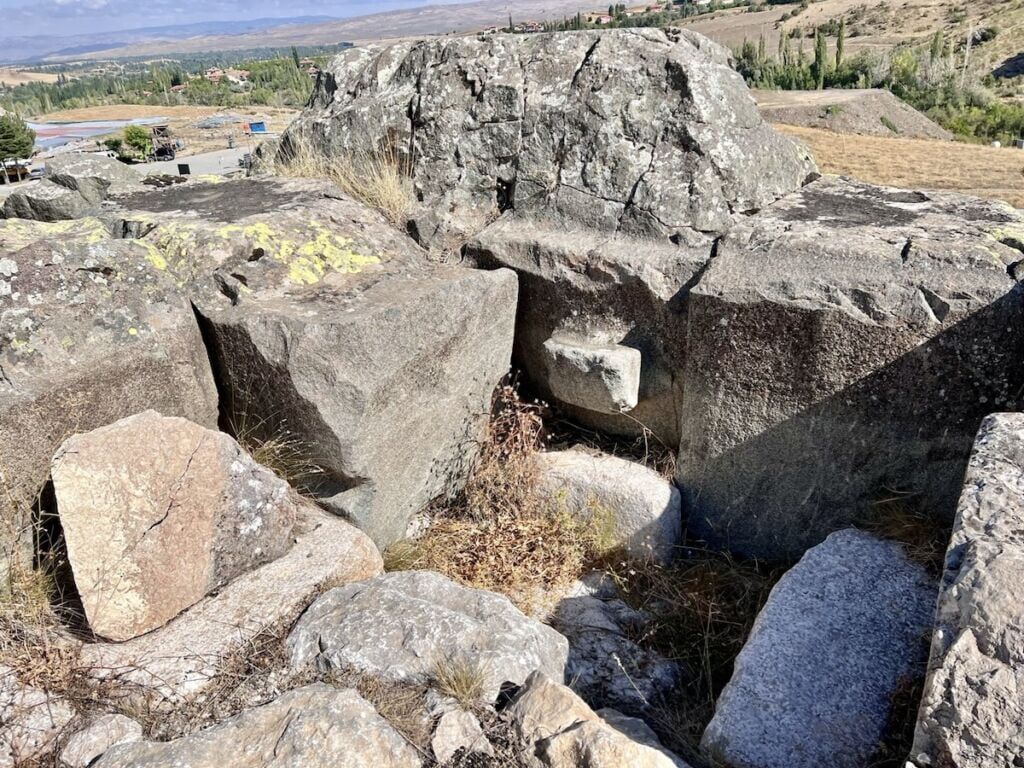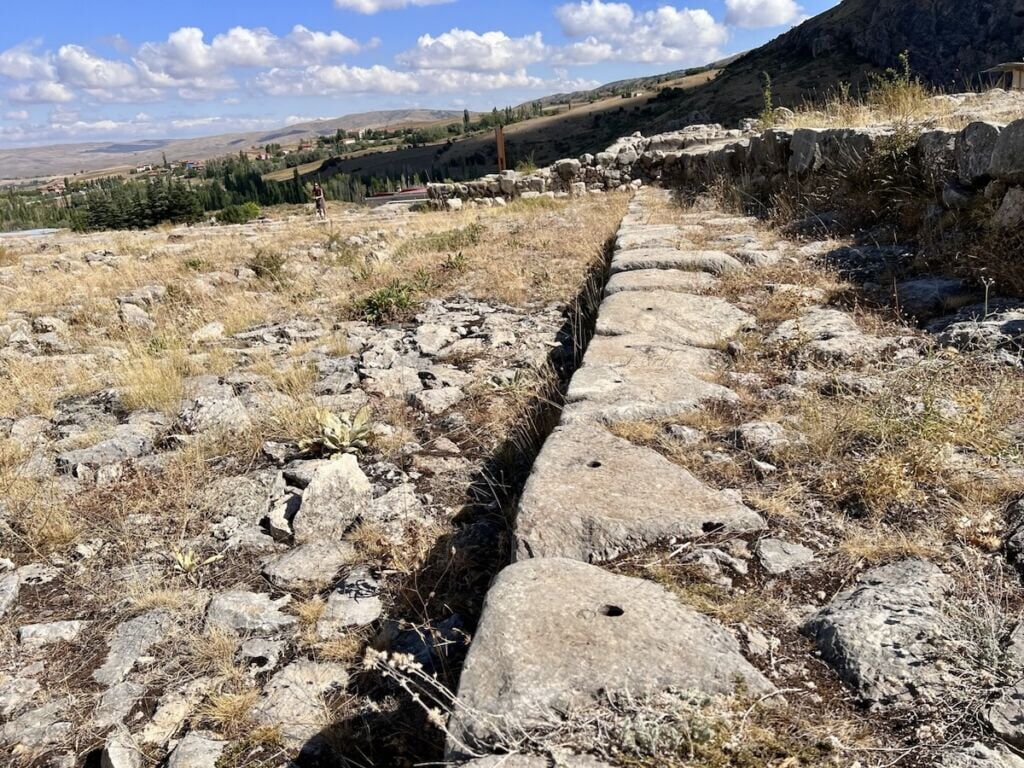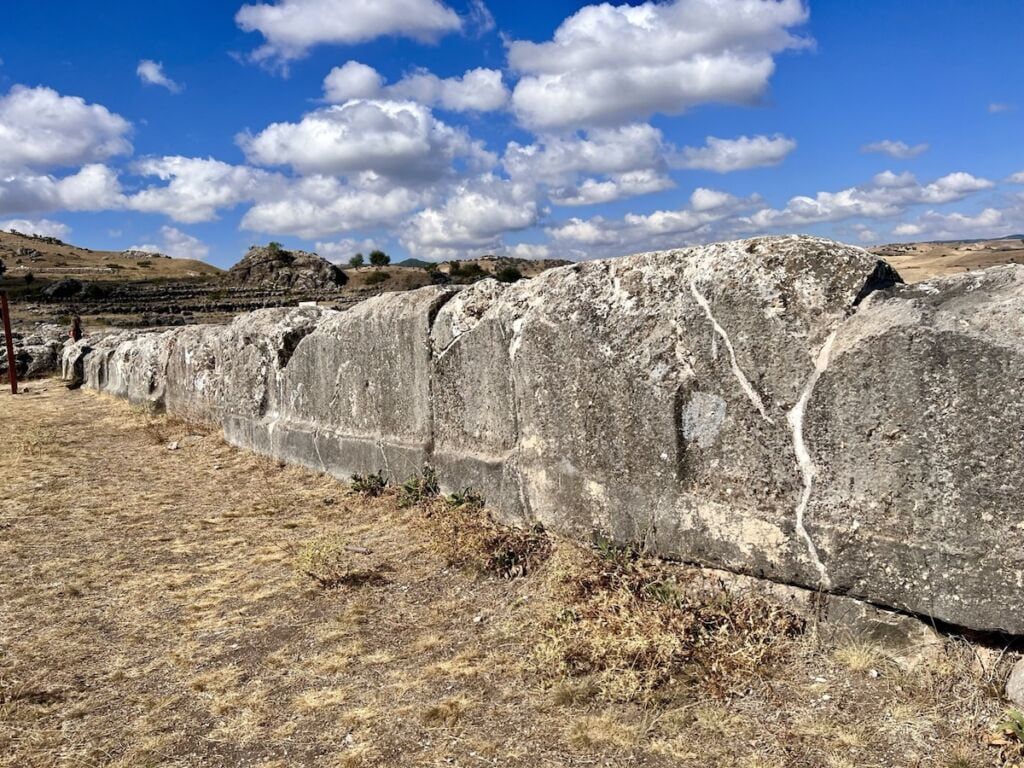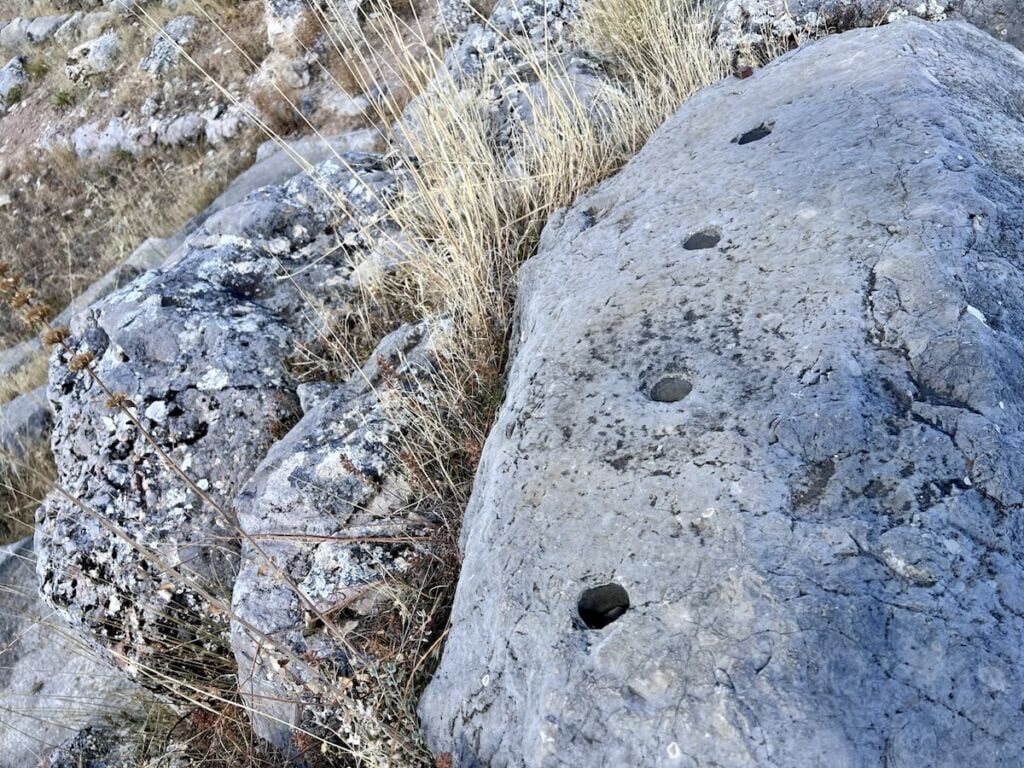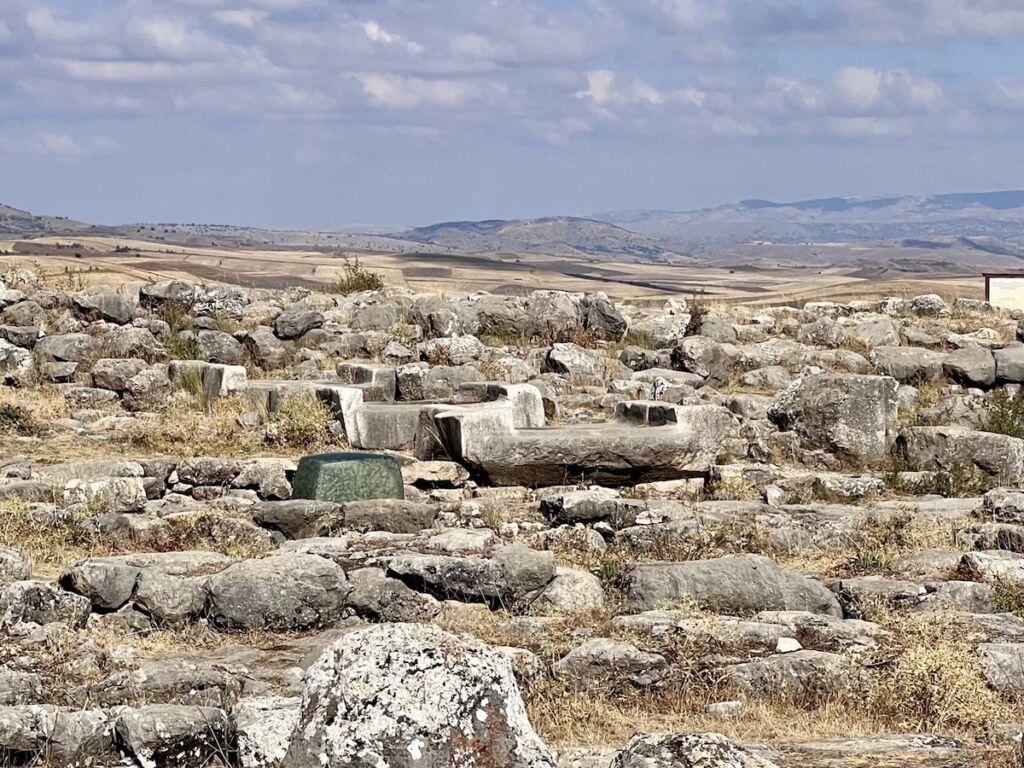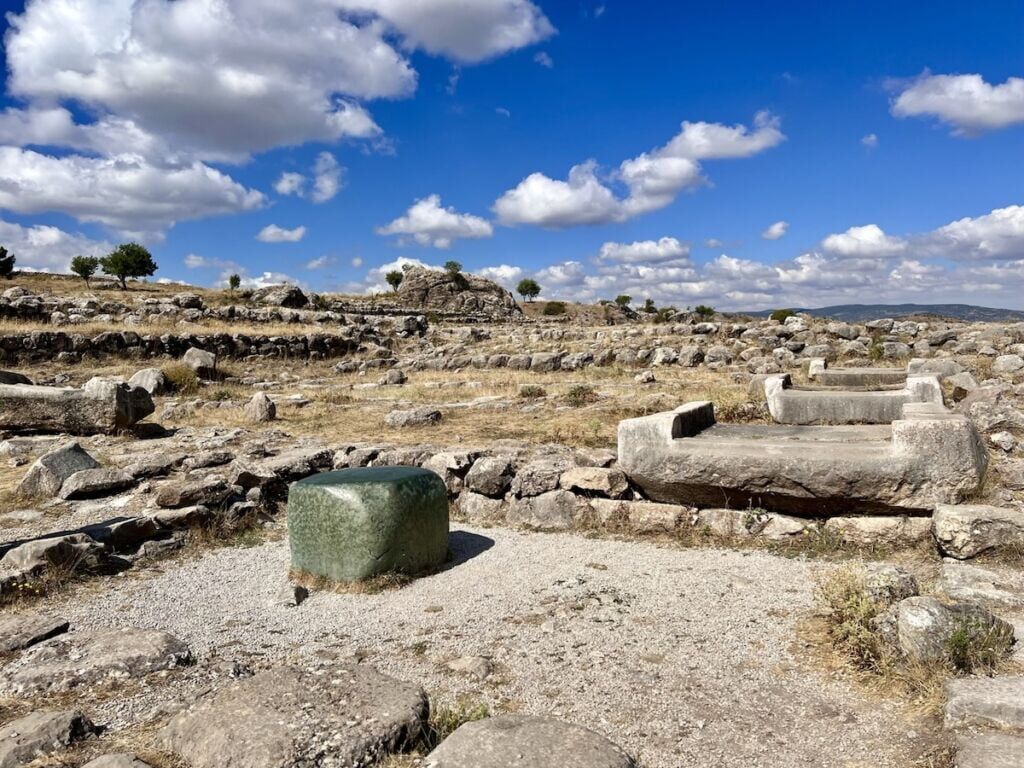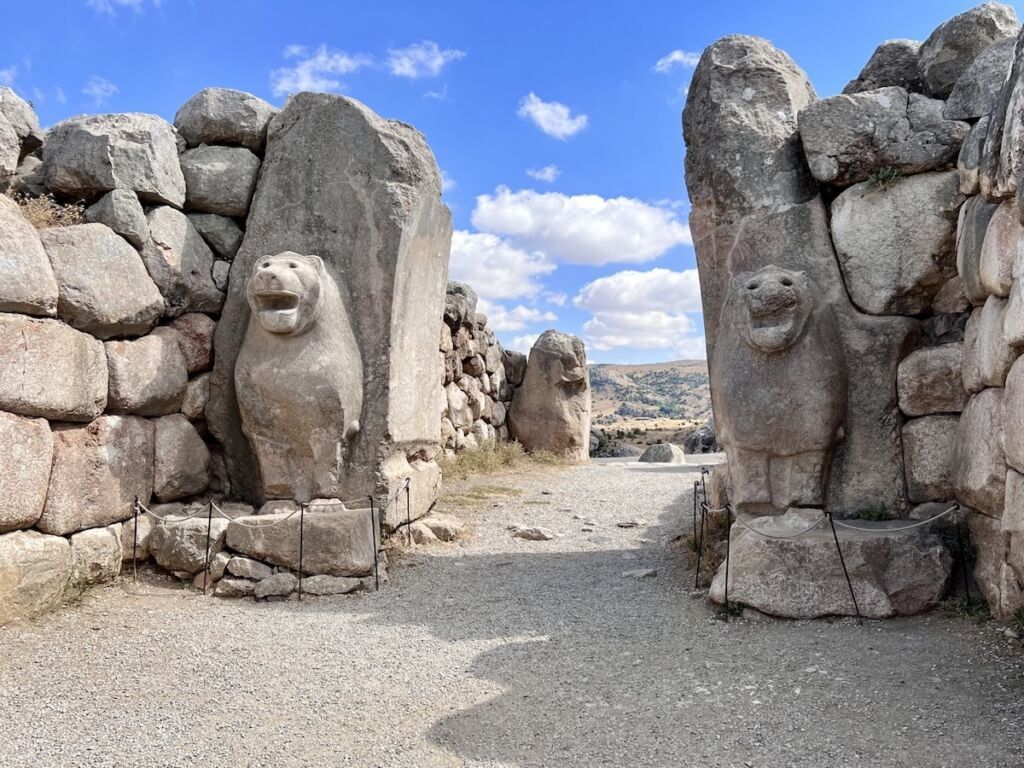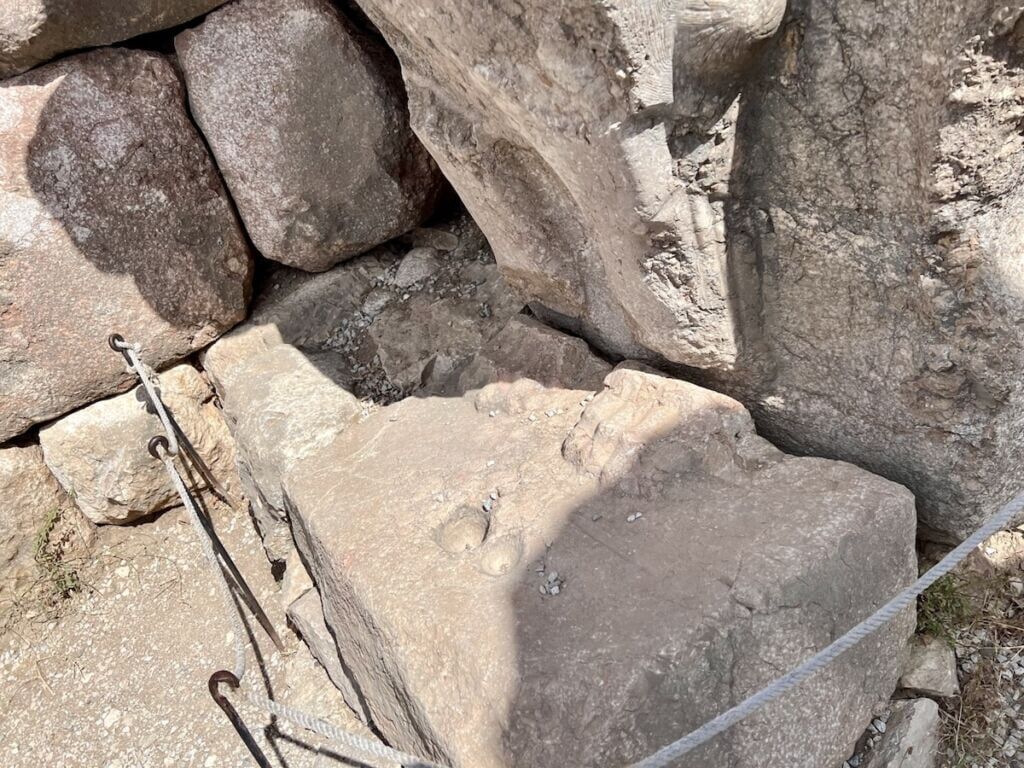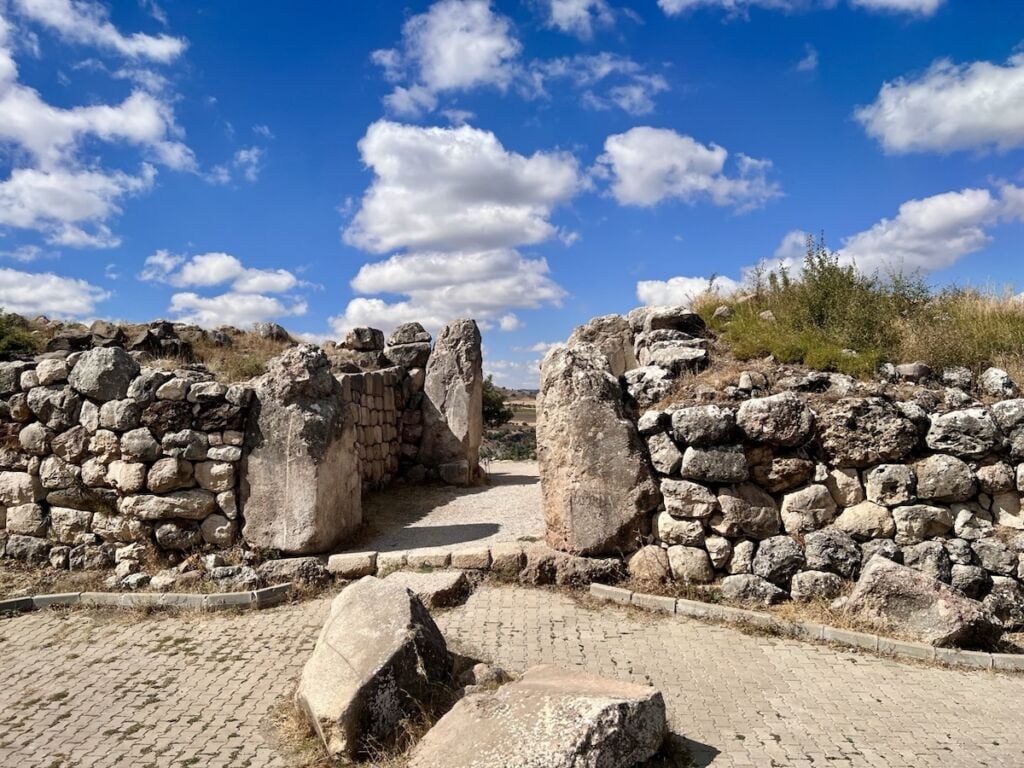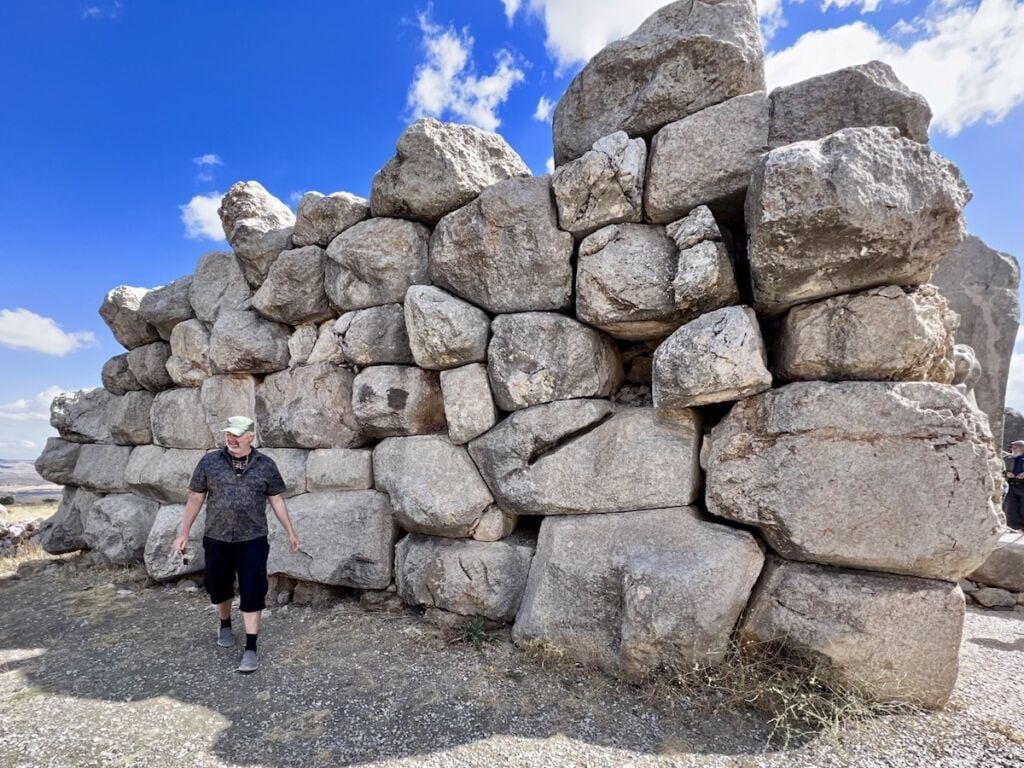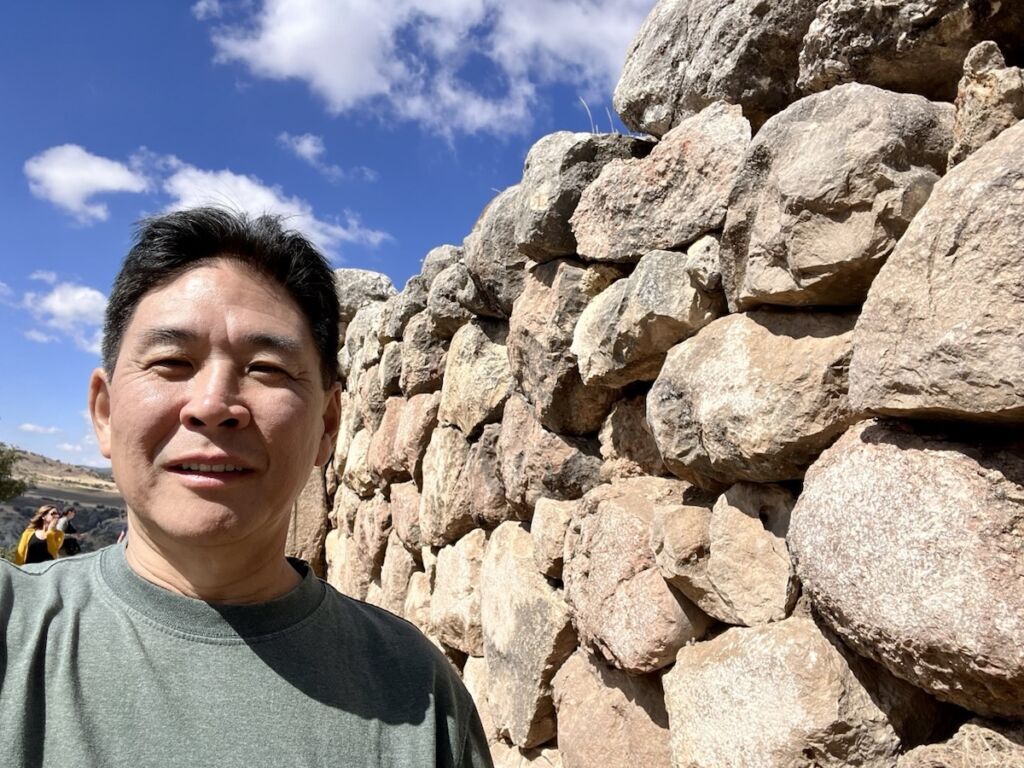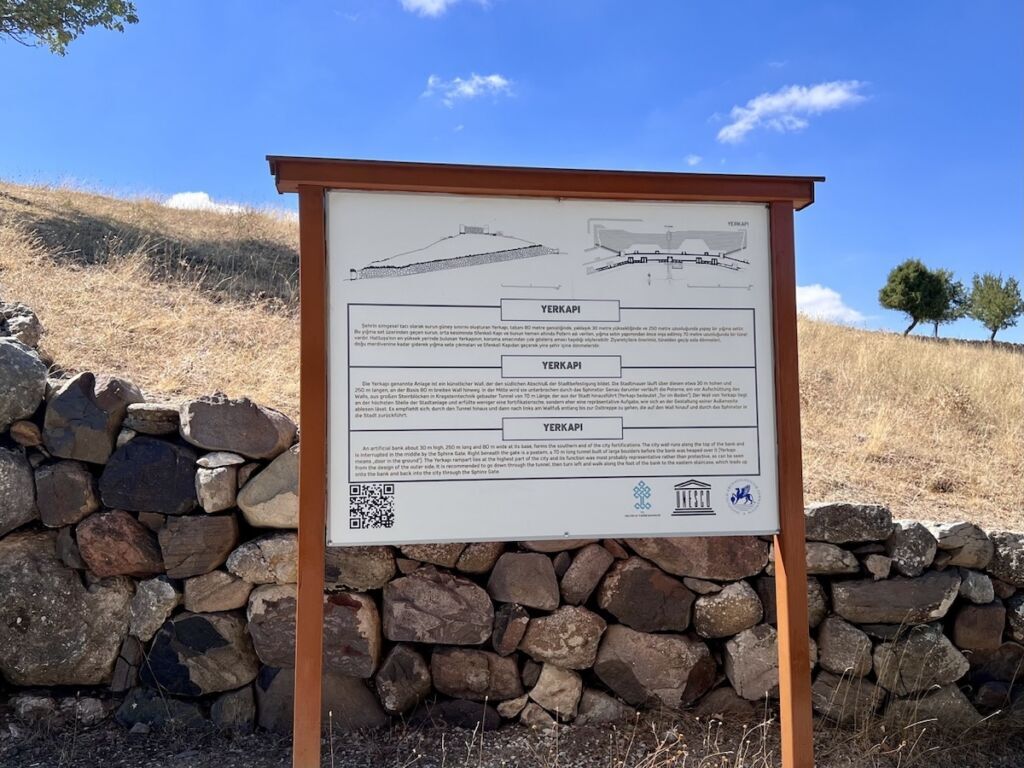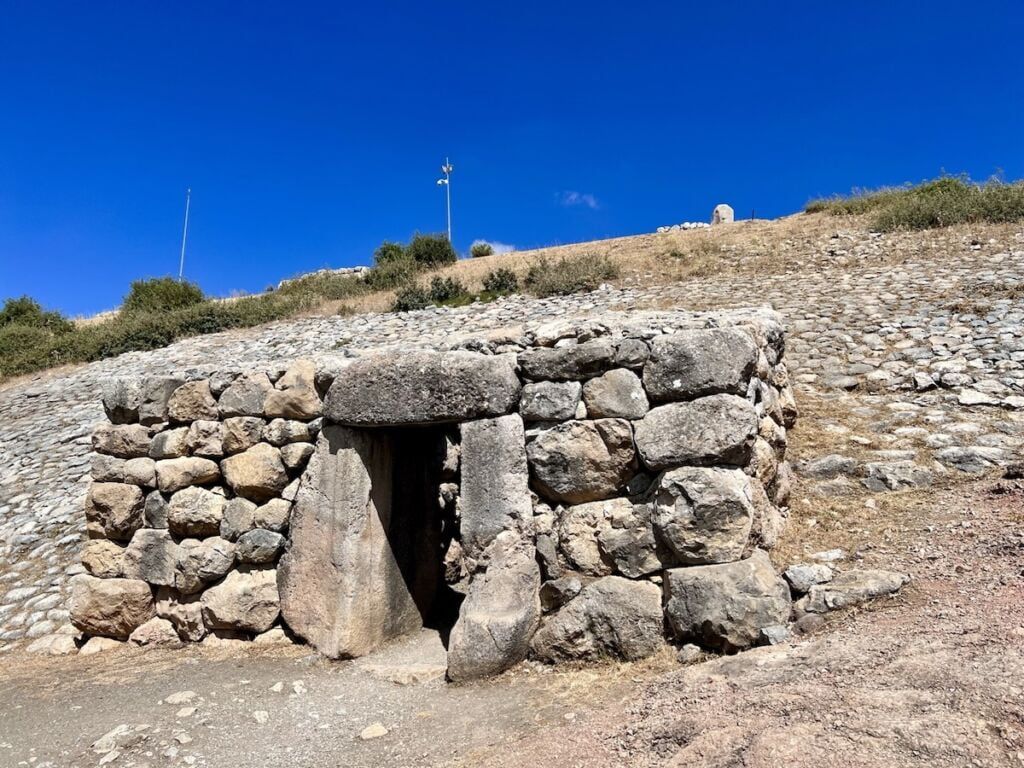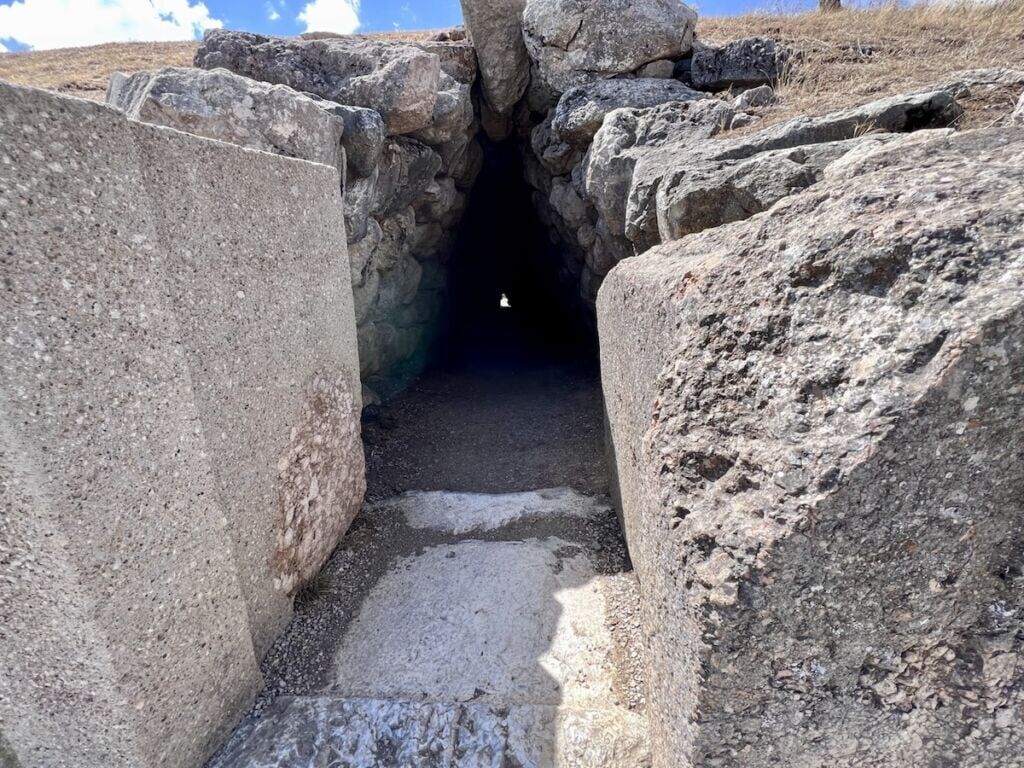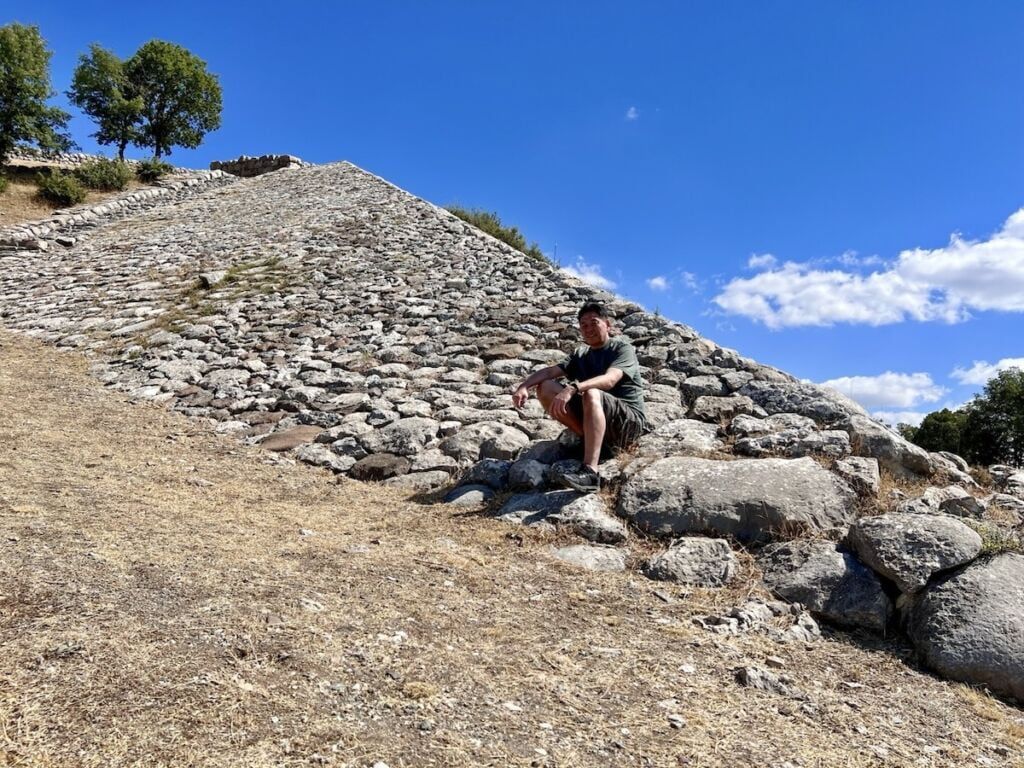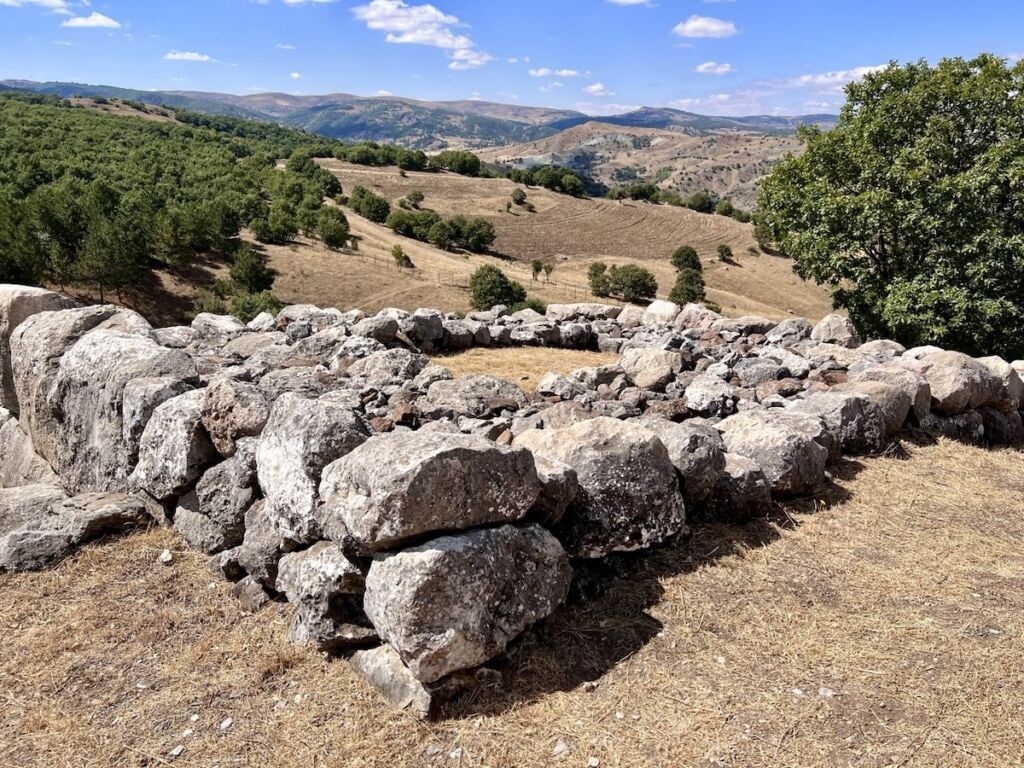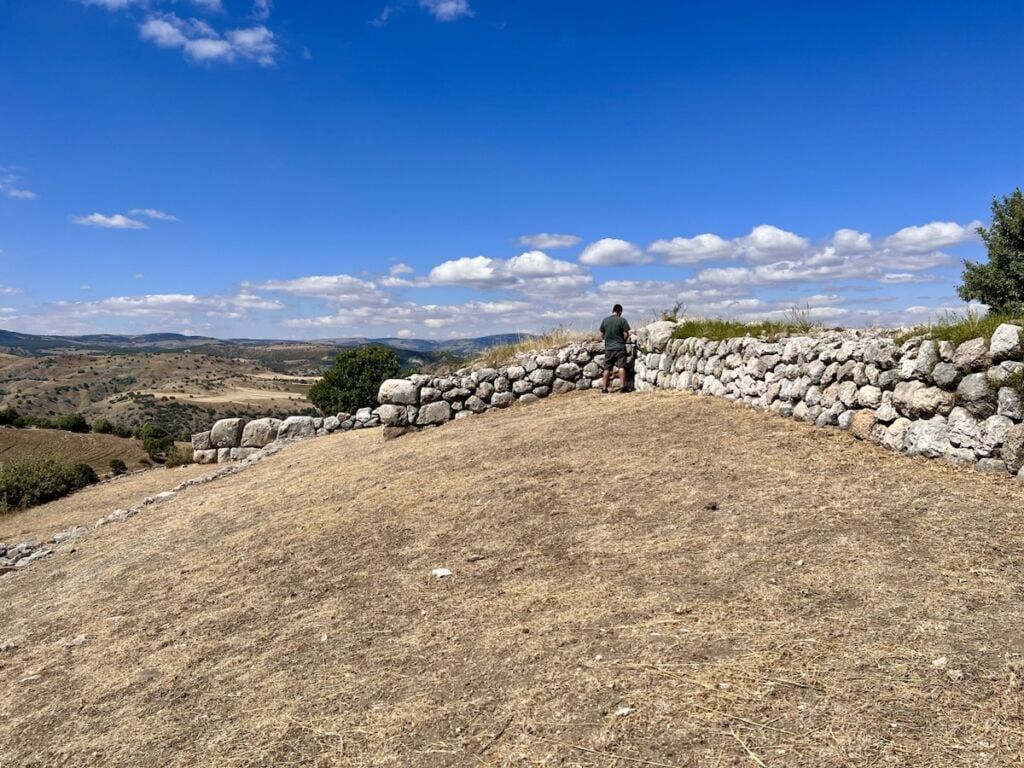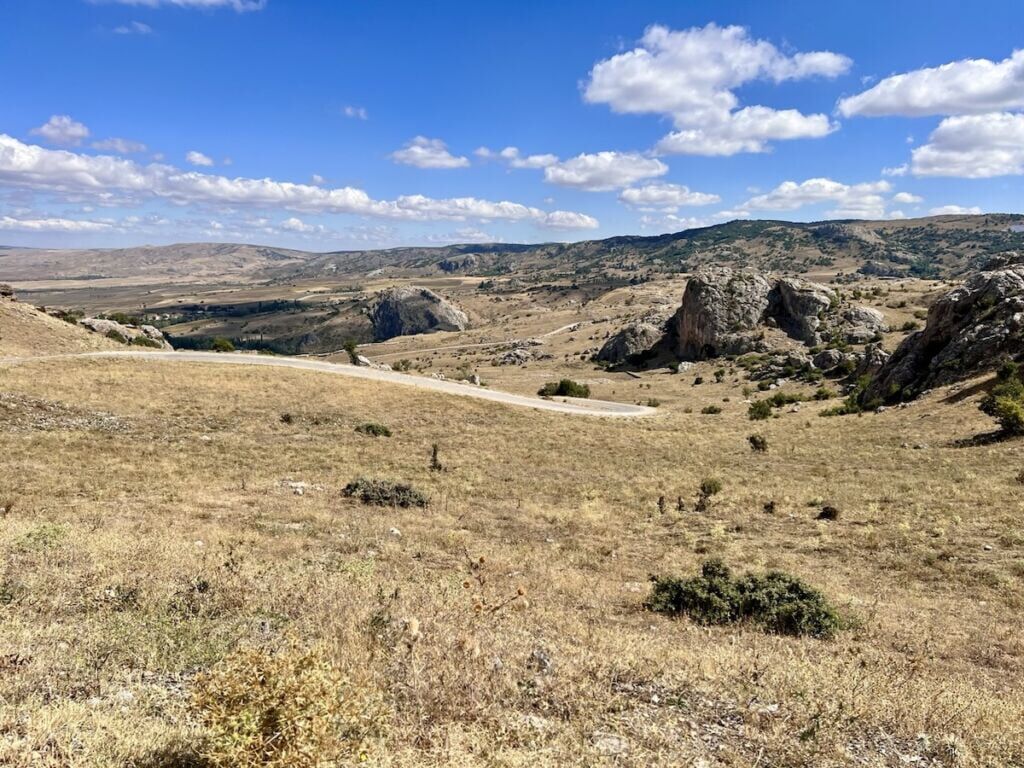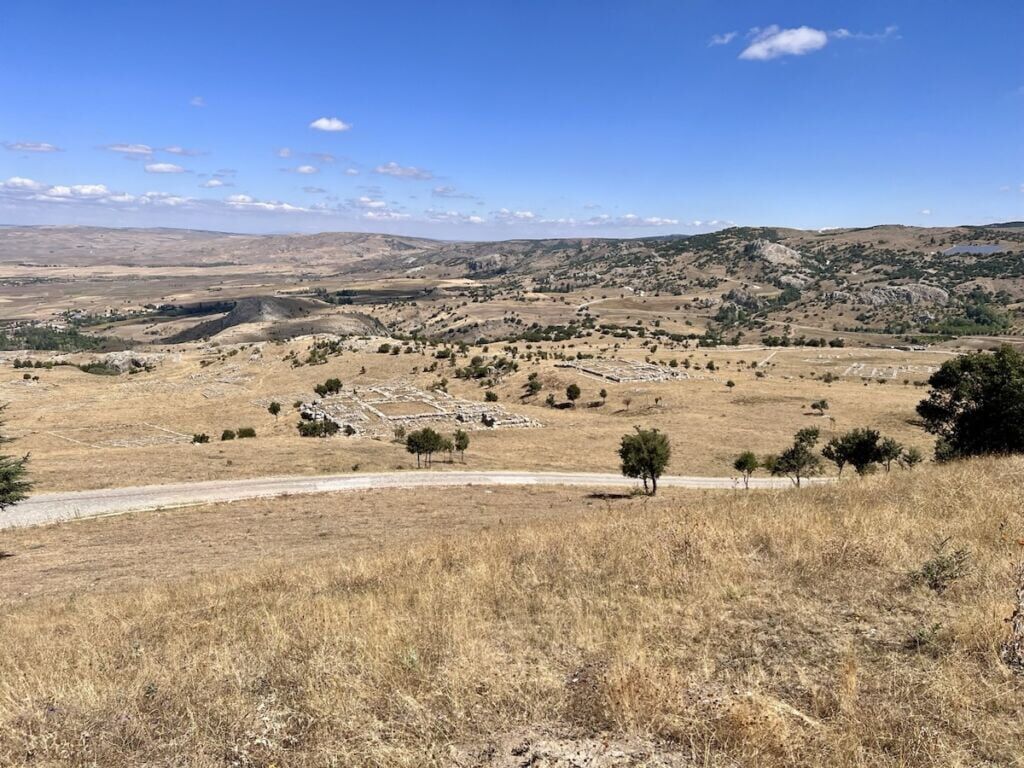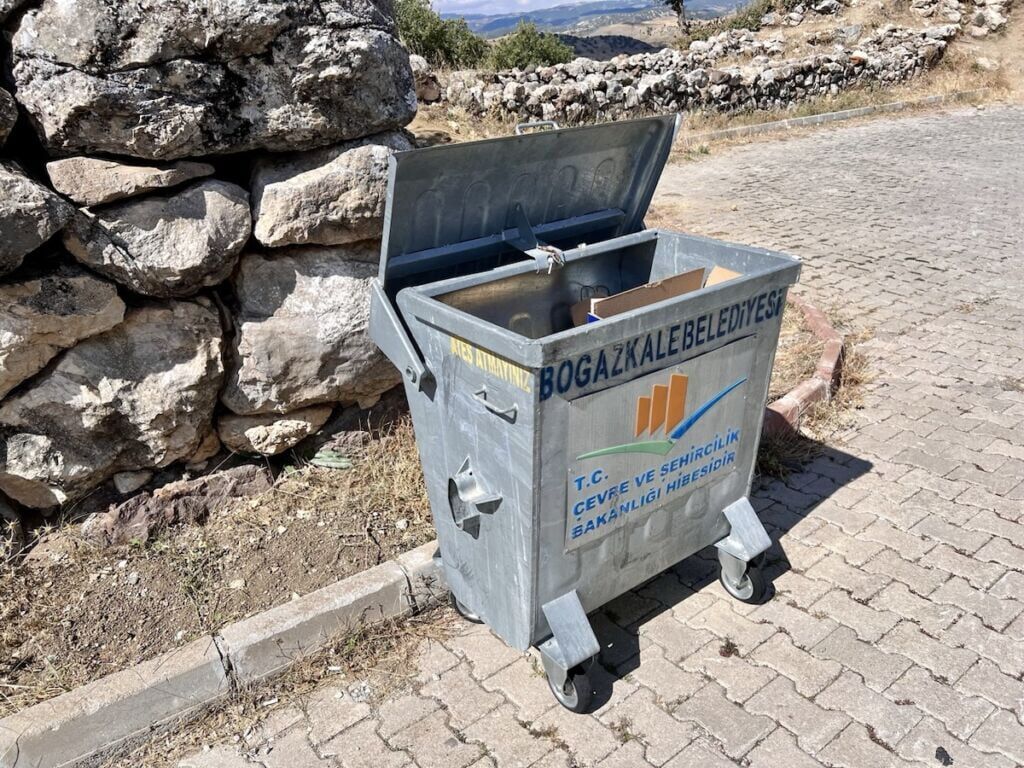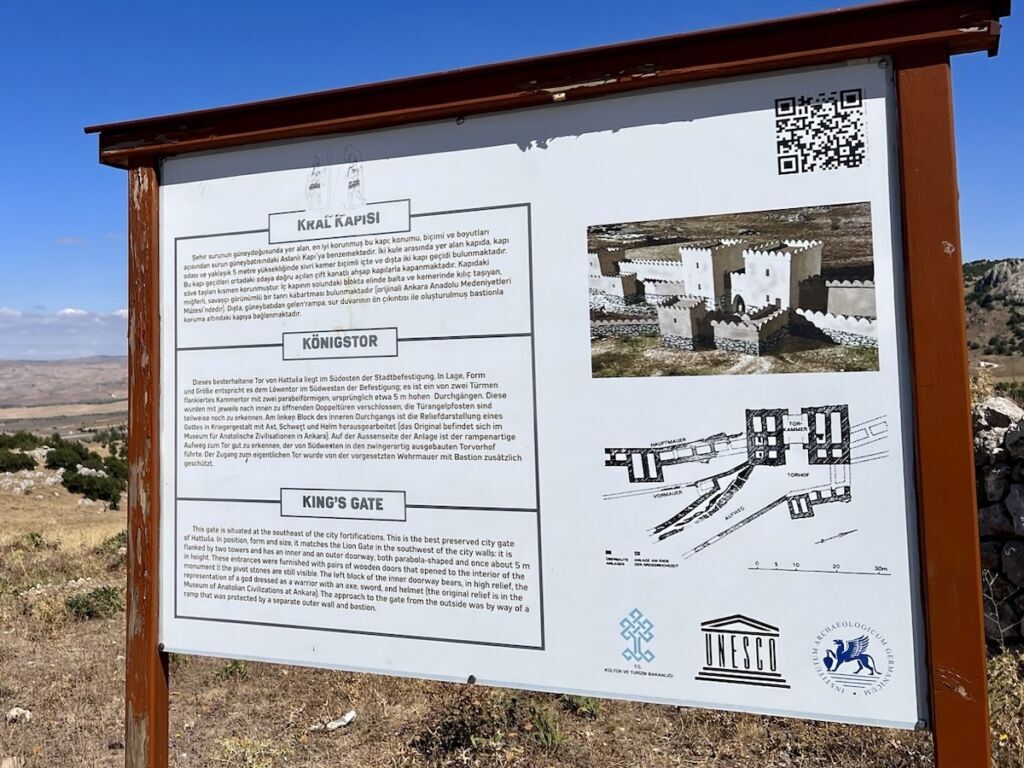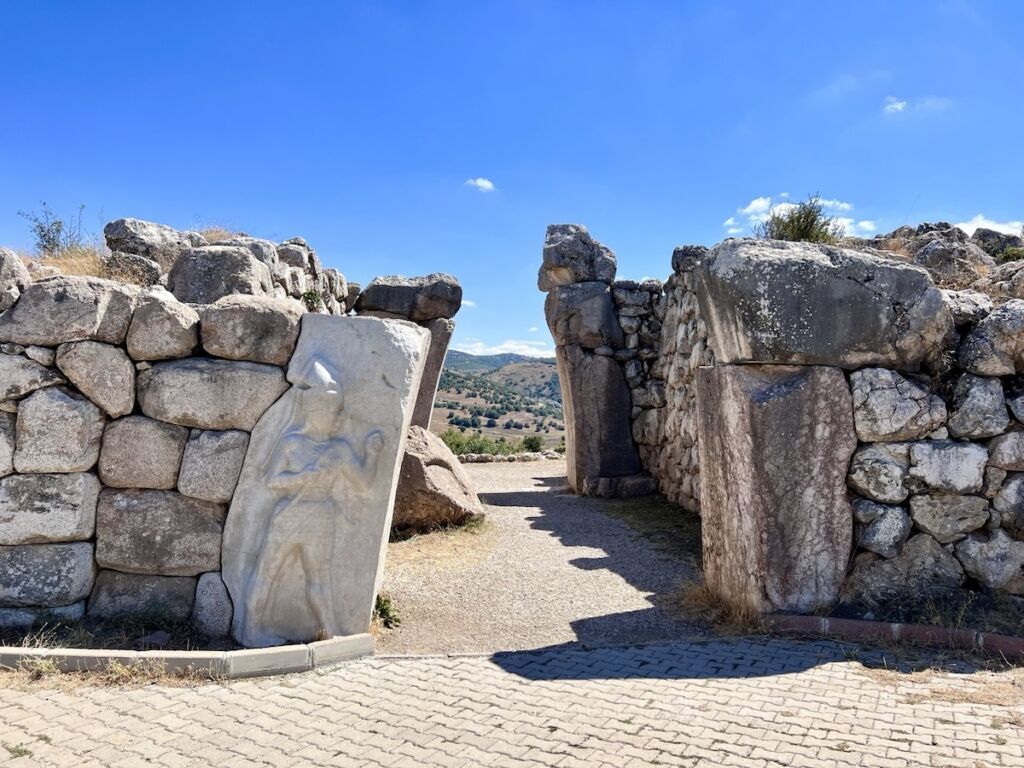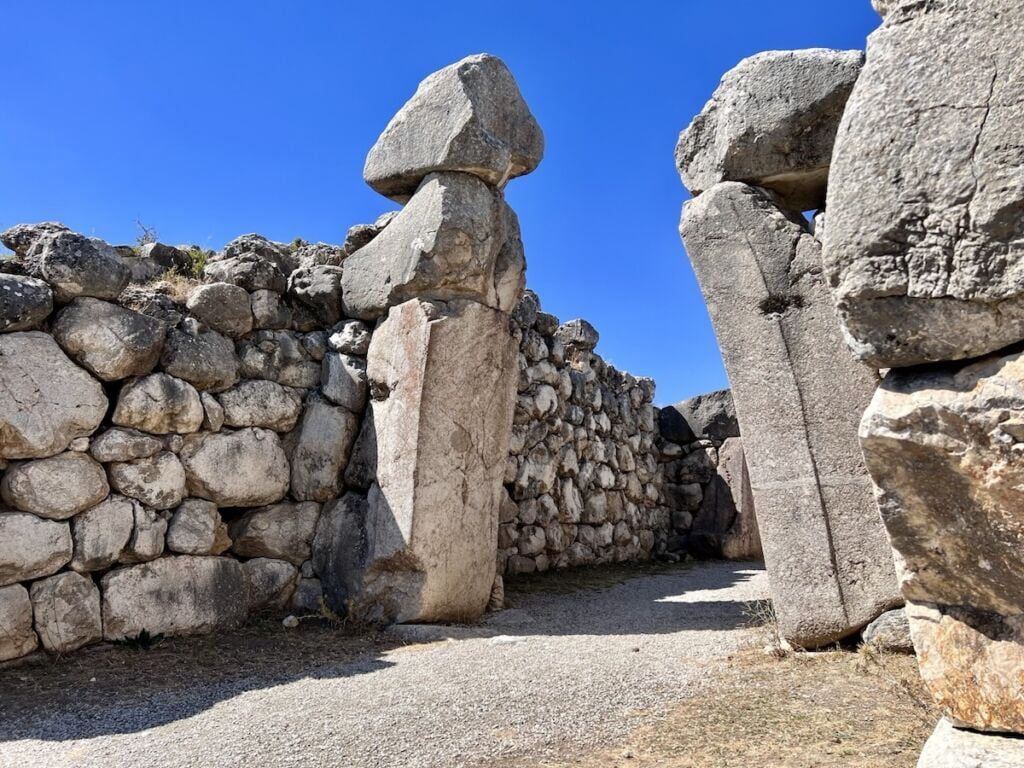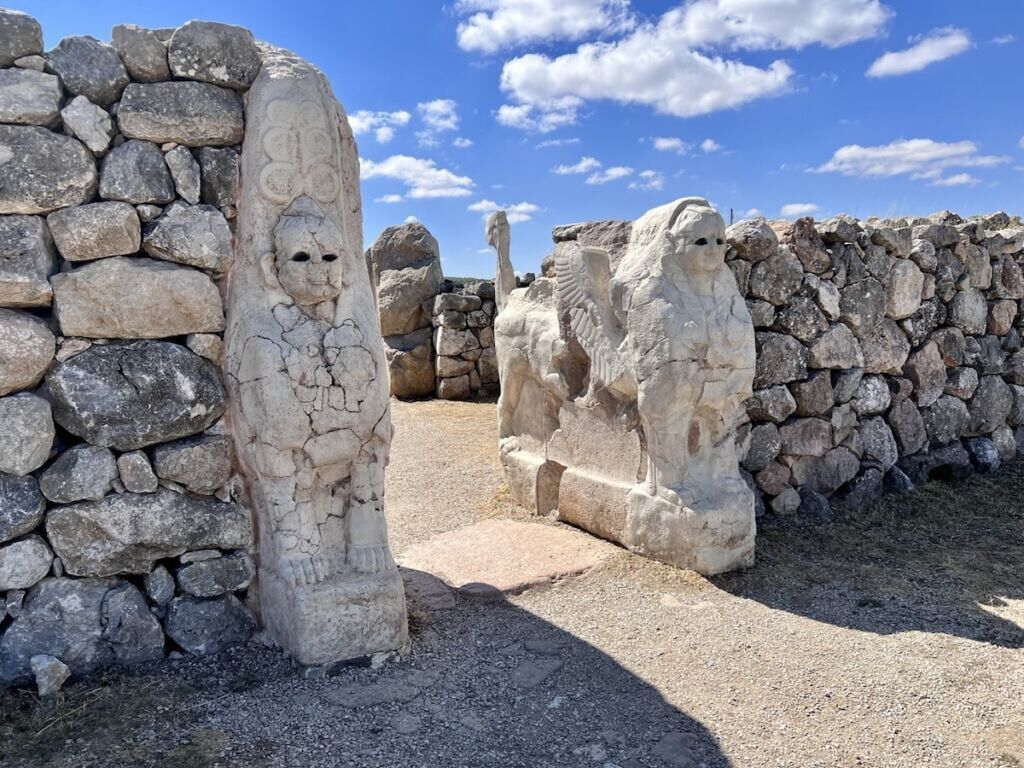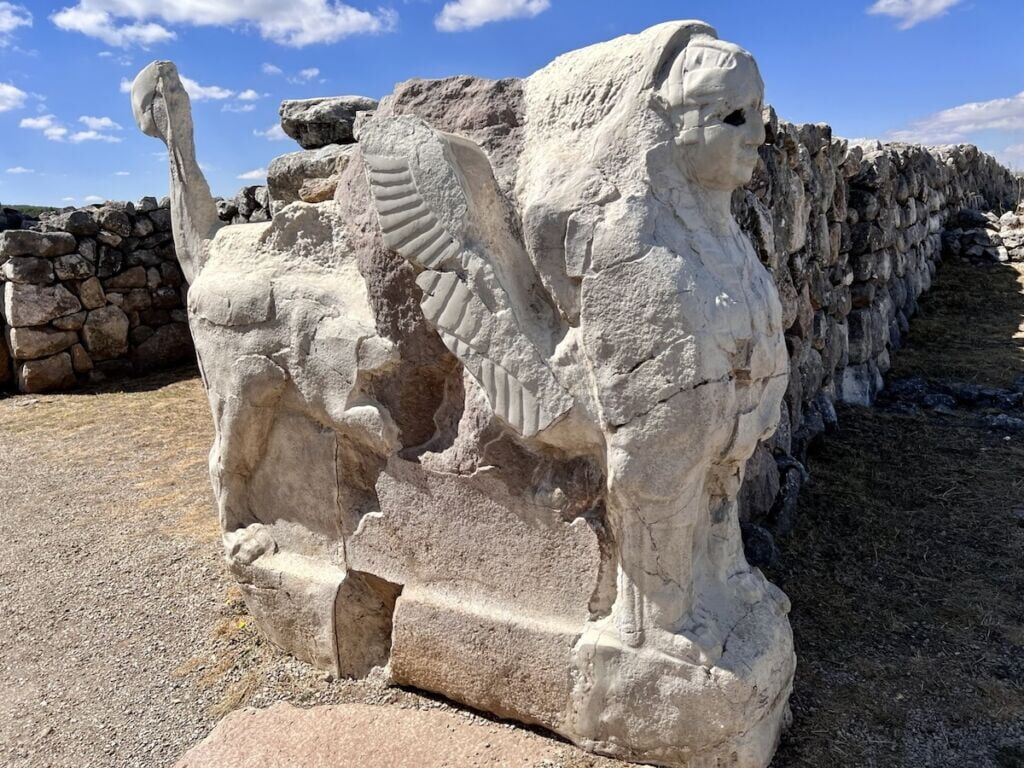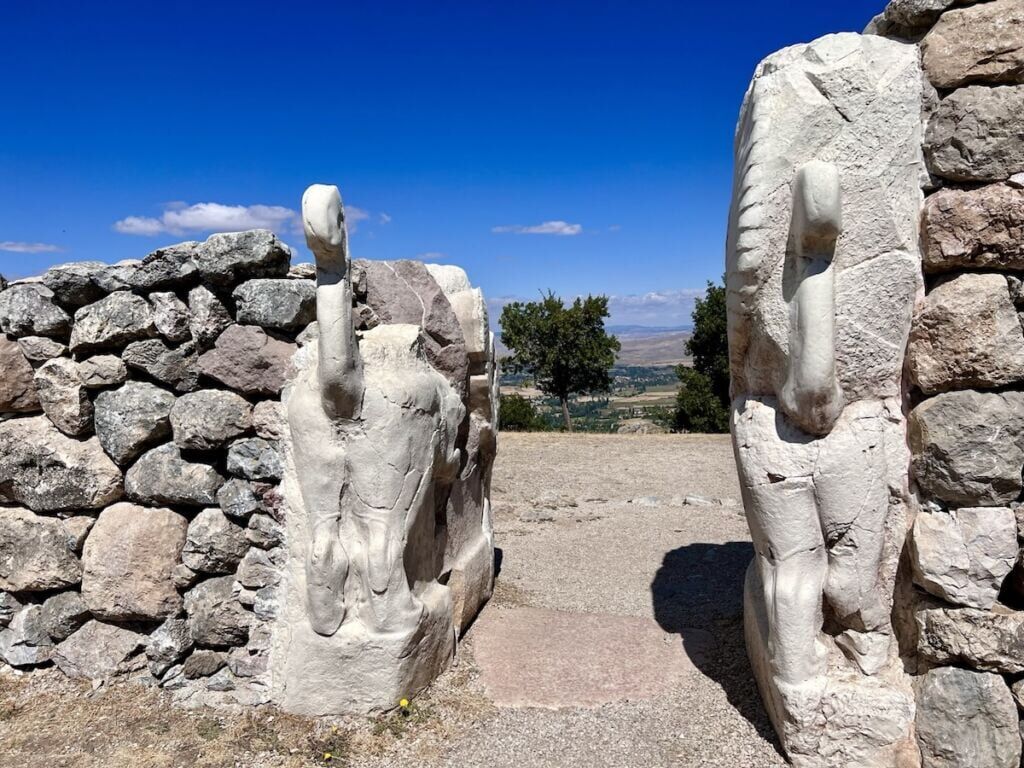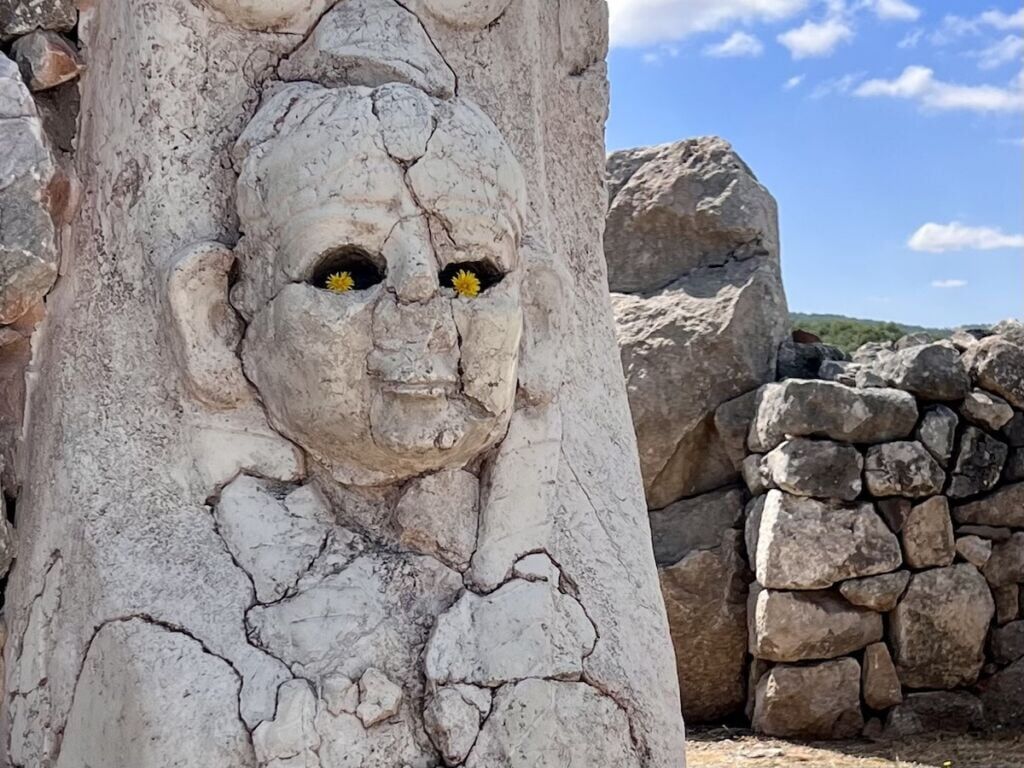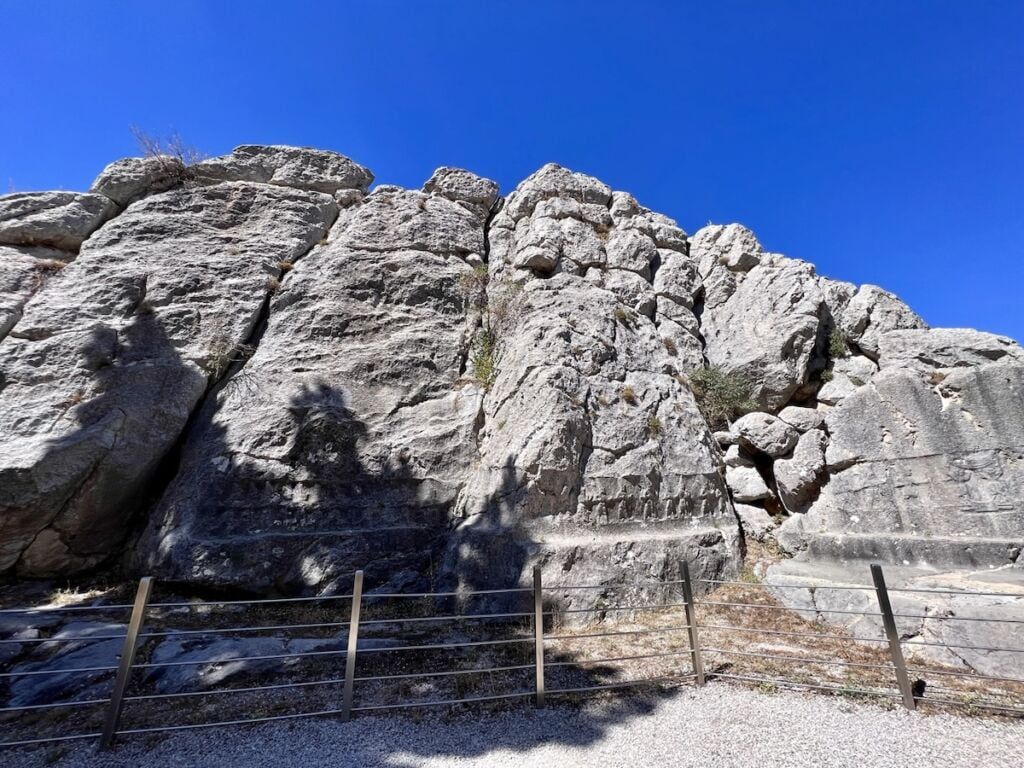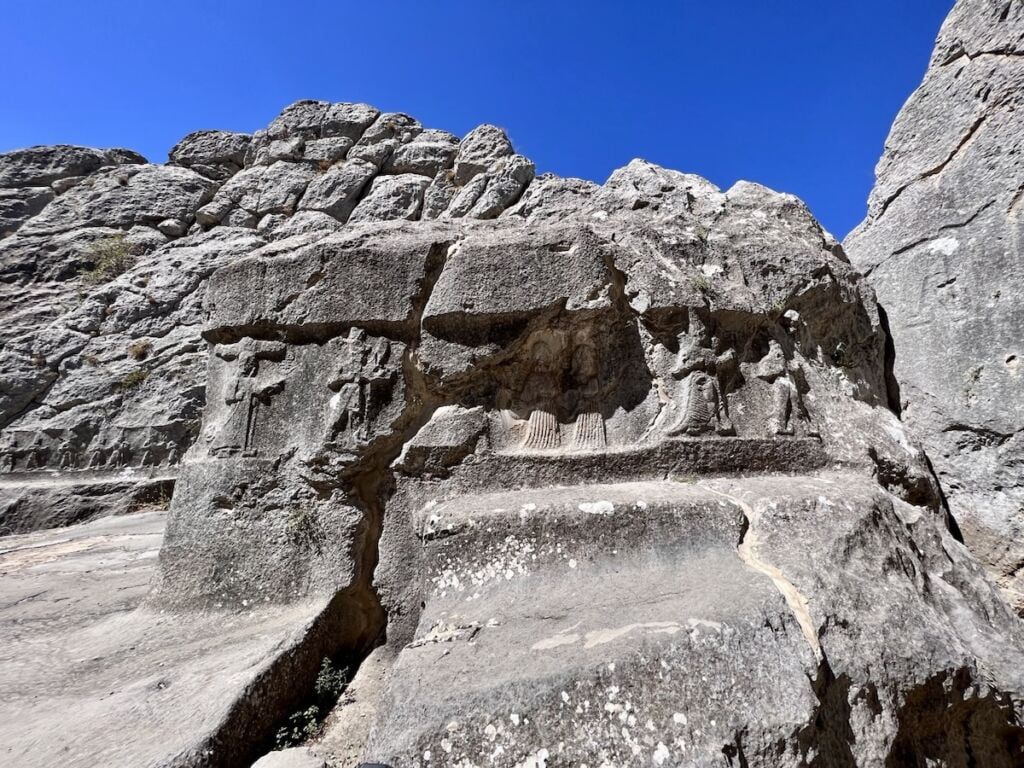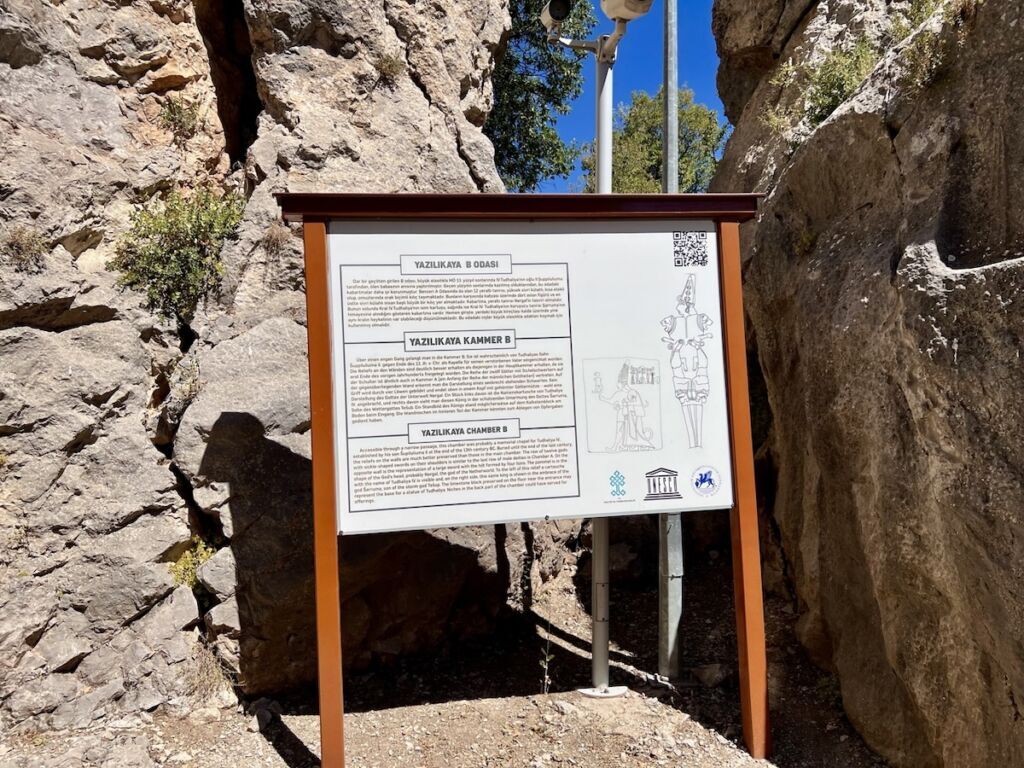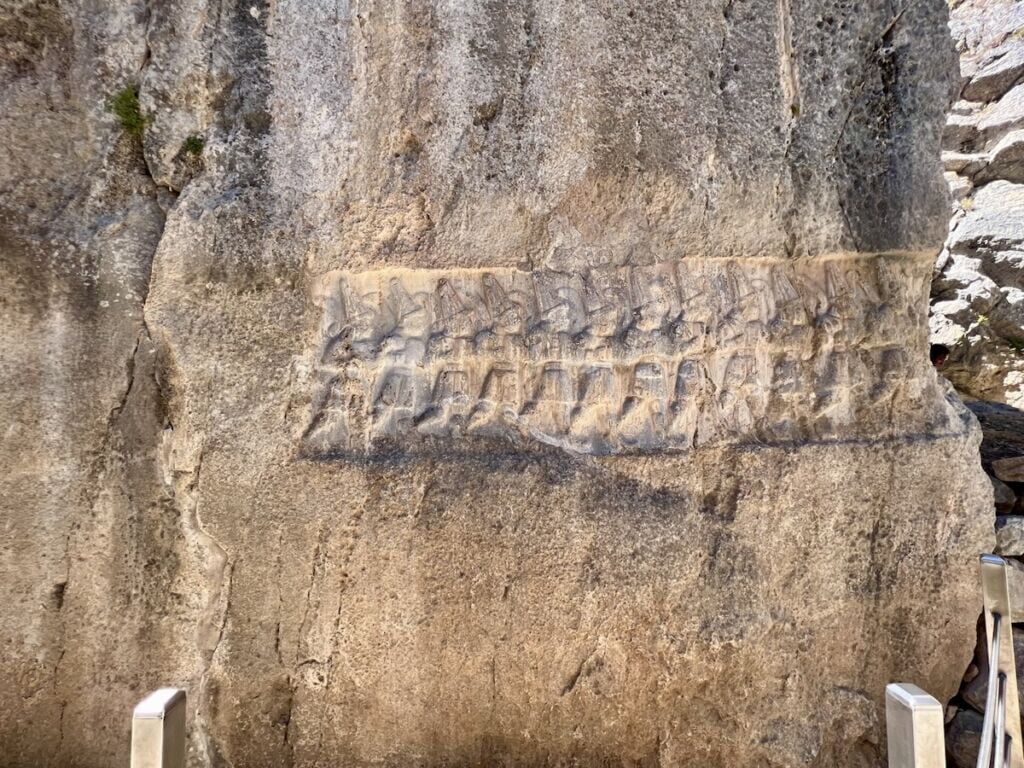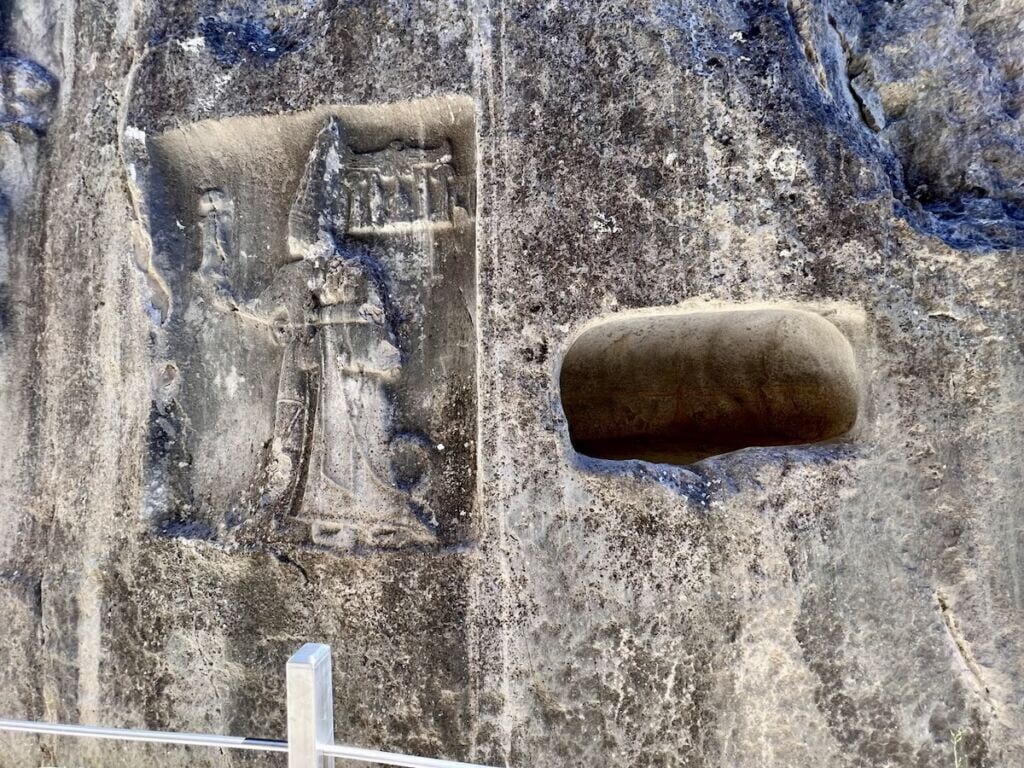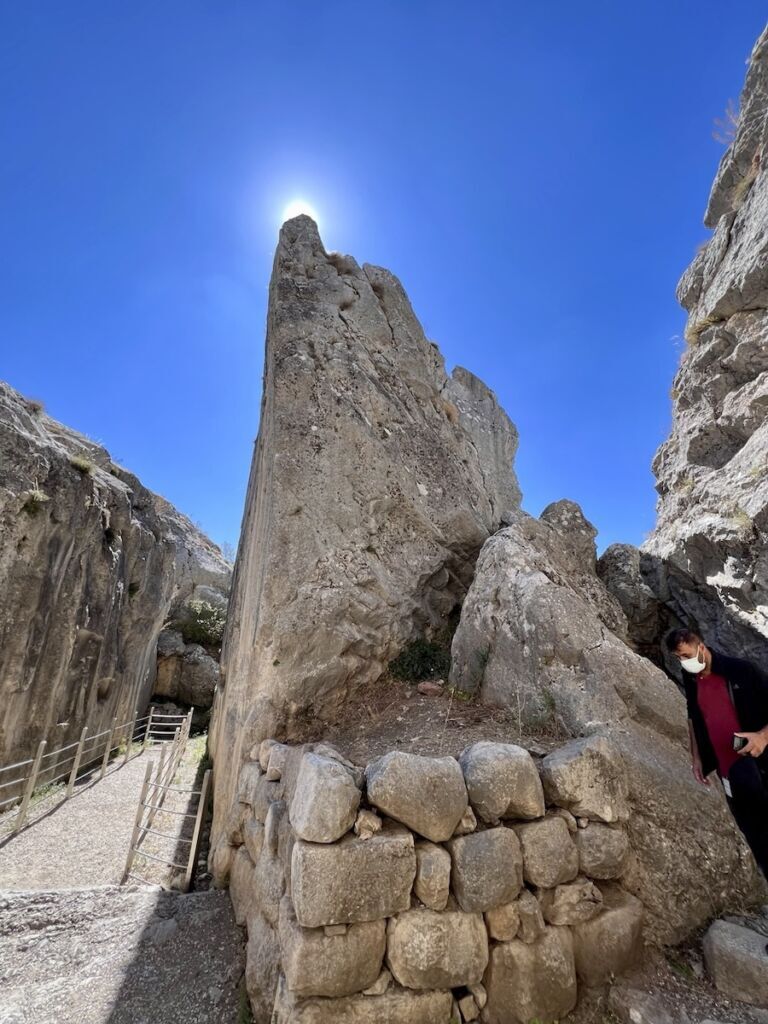Exploring Hattusa and the Mysterious Green Stone
The most mysterious feature of Hattusa is the Green Stone. This was one of the places I wanted to see when I researched the Megalithomania Ancient Turkey tour, because it’s weirdly out-of-place, one-of-a-kind, and no one knows what it’s really doing there. What could this have been for? And why is it still here?
Hattusa, a UNESCO Heritage Site in Turkey, was the captal of the Hittite Empire, a Bronze Age civilization from about 4000 years ago. Hattusa features large fortifications, grand temples, and intricate rock carvings.
Sidebar: We had a couple of COVID-19 moles on our tour bus. Tragic story below,
Wed, Sep 7: Hattusa, Turkey
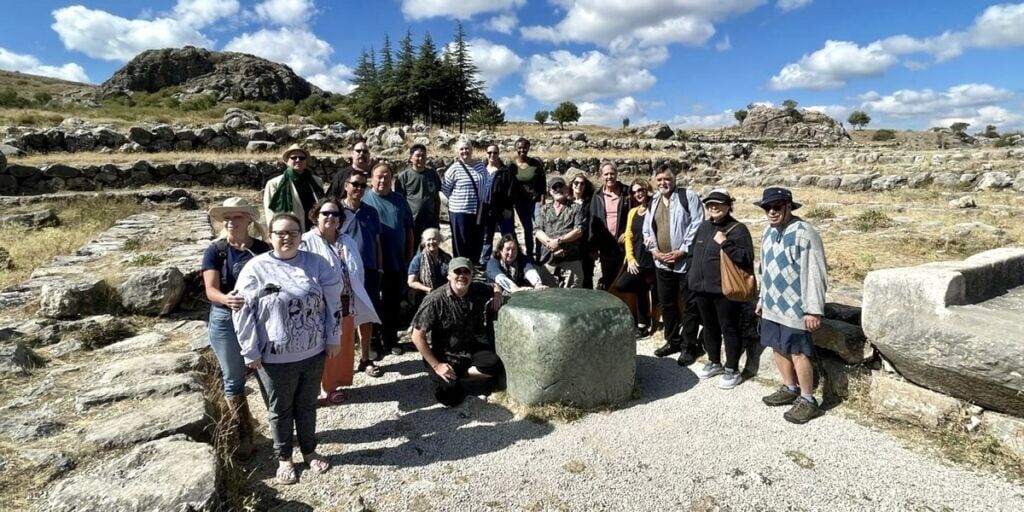
Mysterious Green Stone of Hattusa
The Hattusa Green Stone is a rough cube of green jadeite located in the Great Temple at Hattusa, Turkey.
| Composition: | Jadeite, though some say Nephrite or Serpentinite |
| Dimensions: | A cube about 27 inches (69 cm) per side |
| Weight: | About 2,200 pounds (1000 kg) |
| Age: | 3200 – 3600 years old |
| Purpose: | Unknown. Wishing Stone. Religious artifact. |
With all the specifications out of the way, let’s have a closer look at the green stone. It’s smooth all over possibly from weathering and from all the people who come to touch it. It’s kind of surprising that no one has come by and taken it home in all this time. I had some quiet time with the stone, and did at 3D scan so you can better see what it actually looks like. Enjoy.
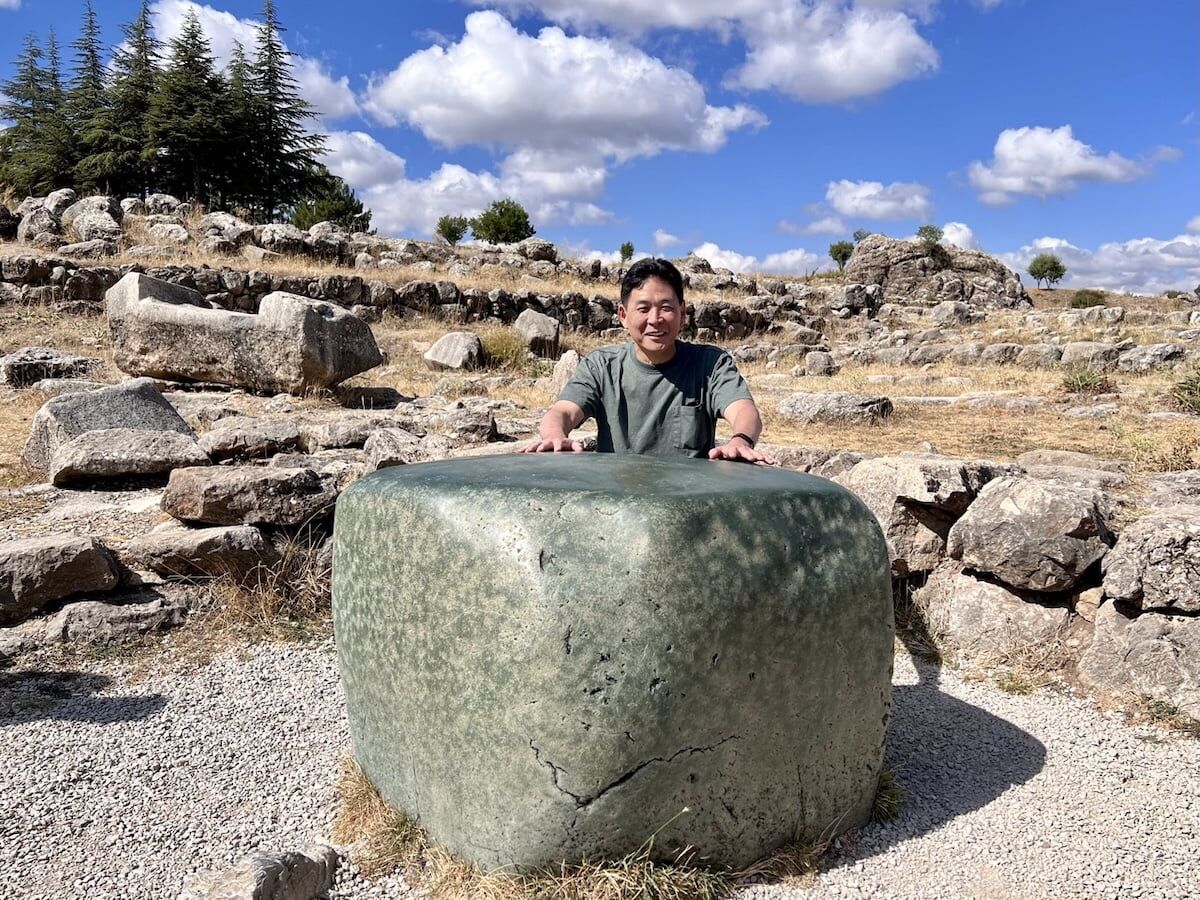
Hattusa Great Temple
The Hittite Great Temple is in the lower city of Hattusa. This is where the Megalithomania tour bus enters the site. Pass by the reconstructed city wall and you arrive at the great temple and surrounding sites.

The Fierce Hattusa Lion Gate
The Lion Gate is about 3400 years old. The gate has two arched openings that used to have wooden doors, possibly reinforced with bronze. The namesake lion statues flank each side of the outside door. These fierce lions have their mouths open and eyes wide. Some people think these lions were supposed to keep evil spirits away.
What’s also amazing about the Lion Gate is its construction. These polygonal stones fit together without mortar such that you can’t even fit a piece of paper between them. The Lion Gate is similar to another gate with lions in a place called Mycenae, which shows how people in different places built things in similar ways. An interesting thing to note is that the gate appears to have never been completely finished. This is because some of the stones at the top are not smooth.

The Gate in the Ground: Hattusa Yerkapi
Yerkapı (pronounced: yair-KAH-pee) is part of the ancient city of Hattusa and is famous for its unique and old tunnel. The tunnel was built at a slope of 15 degrees and is made of large stones. It is covered with limestone blocks on the outside. Yerkapı is just one of twelve tunnels found in Hattusa, but it is the best one that has been kept in good condition.
The tunnel was built around 3400 years ago by the Hittites. They used a special building method called a corbelled vault because they couldn’t make true arches. This method has allowed the tunnel to last for more than 3,000 years. Today, the tunnel is still strong and can be walked through, although some of its original decorations are gone. Yerkapı is at the highest point of the city, offering great views of Hattusa and the nearby areas that were once farmed. This historical site gives a glimpse into the past and the skills of the people who built it.
From the Yerkapi Visitor sign:
An artificial bank about 30 m high, 250 m long and 80 m wide at its base, forms the southern end of the city fortifications. The city wall runs along the top of the bank and
to interrupted in the middle by the Sphinx Gate. Right beneath the gate is a postern, a 70 m long tunnel built of large boulders before the bank was heaped over it (Yerkap
means “door in the ground”). The Yerkapi rampart lies at the highest part city and its function was most probably representative rather than protective, as can be seen from the design of the outer side. It is recommended to go down through the tunnel, then turn left and walk along the foot of the bank to the eastern staircase, which leads up onto the bank and back into the city through the Sphynx Gate.
A Journey Through the Yerkapi Tunnel
Let’s take a walk through the Yerkapi tunnel and see what we can find. Ancient Aliens?
If you like the Yerkapi Tunnel, you’ll love the underground city of Derinkuyu we visited later on the tour.
The Top of the Hattusa Yerkapi Mound
After checking out the Yerkapi tunnel, take a walk around the mound. There are some stone formations on top as well as a commanding view of the city.

The COVID Tragedy at Hattusa
So today we learned that a couple brought COVID-19 onto the tour bus from the start – exposing the entire group as we spent many hours on the bust. We masked up for a few days while people were tested. In the end, it was too little too late and five people left the tour early. That’s tragic as they spent thousands to get here and they didn’t even get to see the main sites, like Gobekli Tepe and Karahan Tepe.

The Mistaken King’s Gate at Hattusa
The “King’s Gate” in Hattusa was mistakenly named due to an initial misinterpretation of a relief, which was originally thought to depict a Hittite king. Subsequent research revealed that it more likely represents a warrior or a war god, as indicated by the horned helmet. Despite this, the name “King’s Gate” remains due to its established usage in historical contexts.
From the King’s Gate visitor sign:
This gate is situated at the southeast of the city fortifications. This is the best preserved city gate of Hattusa. In position, form and size, it matches the Lion Gate in the southwest of the city walls: it is flanked by two towers and has an inner and an outer doorway, both parabola-shaped and once about 5 m in height. These entrances were furnished with pairs of wooden doors that opened to the interior of the monument & the pivot stones are still visible. The left block of the inner doorway bears, in high relief, the representation of a god dressed as a warrior with an axe, sword, and helmet (the original relief is in the Museum of Anatolian Civilizations at Ankara). The approach to the gate from the outside was by way of a ramp that was protected by a separate outer wall and bastion.

The Spooky Sphinx Gate at Hattusa
The Sphinx Gate at Hattusa is located in the upper city and features a tunnel-like passage with arches. Its name derives from the two original sphinx statues that flanked its entrance, blending human heads with lion bodies. These sphinxes were believed to guard the city from evil forces.
The original sphinx statues are have been relocated to the Berlin Pergamon Museum and the Istanbul Archaeology Museums. Replicas of these statues now stand at the gate.

The Yazilikaya Rock Sanctuary Carvings
Yazilikaya is near Hattusa and is an open-air sanctuary containing rock reliefs. There are two galleries known as chamber A and chamber B. Chamber A has the more intricate carvings.
From the Yazilikaya Chamber B visitor sign:
Accessible through a narrow passage, this chamber was probably a memorial chapel for Tudhaliya IV, established by his son Supiluliuma ll at the end of the 13th century BC. Buried until the end of the last century, the reliefs on the walls are much better preserved than those in the main chamber. The row of twelve gods with sickle-shaped swords on their shoulders is similar to the last row of male deities in Chamber A. On the opposite wall is the representation of a large sword with the hilt formed by four lions. The pommel is in the shape of the God’s head, probably Nergal, the god of the Netherworld. To the left of this relief a cartouche with the name of Tudhaliya IV is visible and, on the right side, this same king is shown in the embrace of the god Sarruma, son of the storm god Tesup. The limestone block preserved on the floor near the entrance may represent the base for a statue of Tudhaliya. Niches in the back part of the chamber could have served for offerings.

As my visit to the incredible ancient city of Hattusa wraps up, I’m amazed by the stories and history hidden in every part of this place. From the huge Lion Gate to the mysterious carvings at Yazılıkaya, and not forgetting the famous green stone that hints at the city’s past mysteries, Hattusa is a place where history comes alive.
t’s perfect for anyone who loves exploring old stories or just enjoys discovering new places. Walking through Hattusa is like stepping back into a world of ancient kings and powerful legends. The ruins and carvings here show us just how creative and smart people were long ago. As I leave, the magic of Hattusa stays with me, reminding me that history is full of surprises and amazing stories waiting to be discovered.
Have you already been to Hattusa and have seen that weird Hattusa green stone, or want to see it? Let us know your thoughts in the comments below.
Part of the Megalithomania UK Gobekli Tepe & Karahan Tepe Turkey Tour
